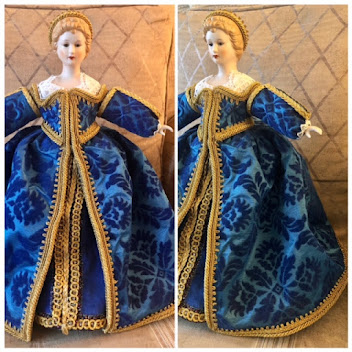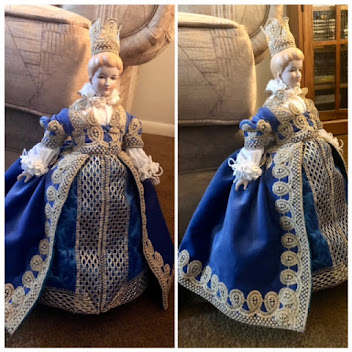Once the air dry clay is dry, use gesso which is a 50% glue and paint mixture to seal and smooth the surface for paint. I do about 3 to 5 layers of gesso with sanding in between to build up and smooth the features. Then after the final layer make sure it dry before painting. I work from medium layer color to lighter colors and work the layers of gouache. Which is an opaque watercolor to create definition by using highlight, low light and some makeup techniques. Then use a matte sealer to avoid a shiny finish but this also protect the paint and clay from moisture.
When I set up my display, out the dolls down flat on the table. Although after working around the table it was sturdy enough later I was able to stand the dolls up without much issue of falling over. Did have one incident where the taller in the middle wanted a hug apparently. She fell over because the binder behind fell and pushed her forward. No damage but will have to keep this in mind for the next time I display these dolls. The wooden mannequins do have good stands attached to the wooden figure so they don't topple easily, which is another good reason for using them as a base. Was wonderful to line up the dolls with their respective renaissance inspiration portrait.
I have more mannequins and terracotta air dry clay this time and am curious how that will show up compared to white air dry clay as used with the sculpted dolls. Want to play with all shades of skin, so I may need to find a gesso or make my own that will be same shade as a smooth and layer before painting. This will play differently with the gouache since you are not starting with a white base but rather a bronze brown base.
When I set up my display, out the dolls down flat on the table. Although after working around the table it was sturdy enough later I was able to stand the dolls up without much issue of falling over. Did have one incident where the taller in the middle wanted a hug apparently. She fell over because the binder behind fell and pushed her forward. No damage but will have to keep this in mind for the next time I display these dolls. The wooden mannequins do have good stands attached to the wooden figure so they don't topple easily, which is another good reason for using them as a base. Was wonderful to line up the dolls with their respective renaissance inspiration portrait.
I have more mannequins and terracotta air dry clay this time and am curious how that will show up compared to white air dry clay as used with the sculpted dolls. Want to play with all shades of skin, so I may need to find a gesso or make my own that will be same shade as a smooth and layer before painting. This will play differently with the gouache since you are not starting with a white base but rather a bronze brown base.
A related to my decades doll research. I have also read up on several different styles of dolls and figurines in related styles and uses. I received a few questions about different kinds of figurines yesterday and wanted to check my notes and give some answers here.
Took a dive into researching French provincial Crèche and Neapolitan Italian Creche figures about. May also see the term Santons or Santos used for these figurines. These are a larger figurine made of terracotta bust, legs, lower arms with wire for the non ceramic part. The 10 gauge wire is wrapped in rough tow fibers to provide body. These figurines are used to make a medieval like town scene where the nativity is nestled somewhere among the hustle and bustle of the “medieval Bethlehem”. These are very elaborate Christmas displays were normally costly investment that is displayed by large churches. Companies still make these figures but their height of popularity was in the early 20th century one of these companies being Fontanini. They currently tend to use resin and other materials to create their figurines in modern day and still sell nativity sets. Most of the smaller sets tend to be a hard figuring and not able to be posed, the larger more expensive sets have more options. These terra-cotta figurine like dolls are heavy and have not found any that are jointed. Other than artist Mannequins or religious Santos which are also within SCA period. I found a pair of German made artist mannequins from 1530's. These are an elaborate anatomically, correct artist mannequin that has specifically detailed facial features as well as styled hair, hands, and feet that have toenails.
 Wooden Santos dolls are jointed dolls and primarily used for the similar religious displays but tend to be a year round item. A large majority of Santos dolls tend to be made of wood and are jointed. These could depict not just the holy family, but also certain Saints. The figure could be dressed and redressed and wigs could be changed out. The features are made in such a way that there are certain poses and facial expressions that could work for several different Saints or different depictions of Mary. Depending on how the scene is set, the large doll dressed, and what items are put with the figurine would determine which saint you are depicting. Crèche figures, Santos dolls with their religious connotations or items that would have a basis in colonialism. These would have been brought to the New World for the purposes of converting the native peoples. Many of these kind of figurines are still very popular in Spain, Italy and Mexico today. These figures tend to be used in religious parades and devotions during the liturgical year.
Wooden Santos dolls are jointed dolls and primarily used for the similar religious displays but tend to be a year round item. A large majority of Santos dolls tend to be made of wood and are jointed. These could depict not just the holy family, but also certain Saints. The figure could be dressed and redressed and wigs could be changed out. The features are made in such a way that there are certain poses and facial expressions that could work for several different Saints or different depictions of Mary. Depending on how the scene is set, the large doll dressed, and what items are put with the figurine would determine which saint you are depicting. Crèche figures, Santos dolls with their religious connotations or items that would have a basis in colonialism. These would have been brought to the New World for the purposes of converting the native peoples. Many of these kind of figurines are still very popular in Spain, Italy and Mexico today. These figures tend to be used in religious parades and devotions during the liturgical year.Feeling Appreciated,
Mairin








No comments:
Post a Comment